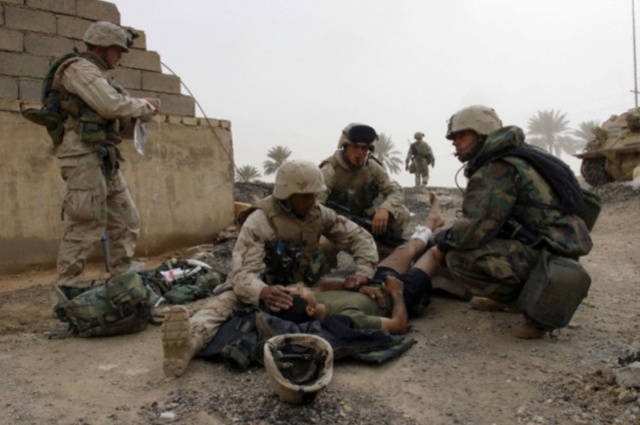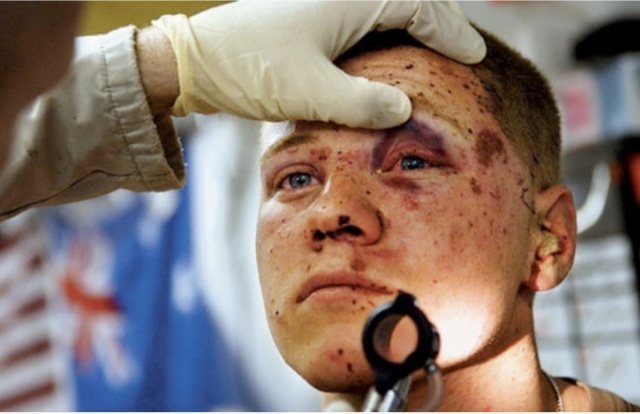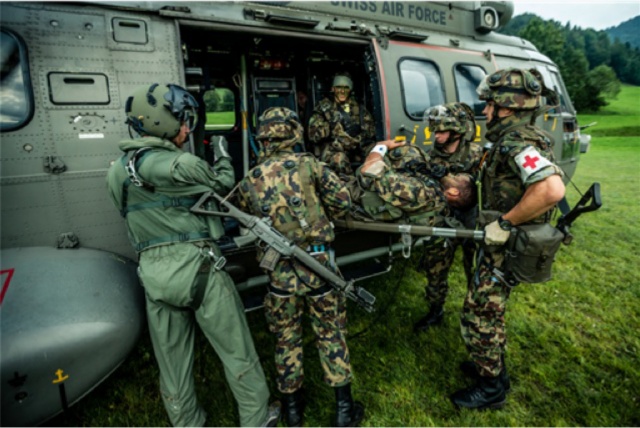
Article: O. ABDEL AZIZ (SWITZERLAND)
Tactical Medicine: The Required Medical Service in the Modern Army
Tactical medicine is the umbrella term for emergency medicine in tactical situations under increased threat, in other words: “Good medicine in bad places.” The experiences of recent military conflicts show that advances in equipment, tactics and training have increased the survival rate of soldiers in combat. An important factor is the continuously improving and faster provision of medical care on the front along with rapid evacuation to the nearest treatment site. This article explains tactical medicine, its history, what it does, and why it is so important in a modern army.
History of Tactical Medicine
Tactical medicine is a form of emergency medicine originally developed to provide care for members of the military. Such medical service is essential based on the obligation to provide first aid to injured comrades and third parties and to preserve the military’s power to engage in combat. The medical service has become increasingly important in recent decades, as illustrated by the following figures from the US military. Excluding the wounded who were able to return to combat within 72 hours, the study calculated the proportion of those wounded who died before receiving initial care from a physician: in World War II, this figure was 20.2%; it was 20% during the Vietnam War, 18.7% in Afghanistanand 13.5% in Iraq(Christian Neitzel and Karsten Ladehof, “Taktische Medizin“, Springer Verlag, 2011, Ch. 1, p. 8, table 1.1).
How was this progress achieved? One reason was rapid evacuation: already in the Vietnam War, wounded soldiers were quickly evacuated by helicopter. This has been steadily expanded in recent years, together with an increase in the number of treatment facilities allowing quicker access to more comprehensive medical care.

One of the most important cornerstones of medical service has been and still remains being able to perform first aid oneself and on comrades under combat conditions. Such first aid is therefore a part of basic training for all modern armed forces. For many years, the US forces too, trained medical service for many years until there was a rethink in the early 1990s. From their experiences at that time, the US recognized that the conventional first aid to oneself and comrades was not optimally suited for battlefield conditions (such as inMogadishu, 1993). The reasons for this:
- The enemy threat was not adequately considered in the first aid. Fighting the enemy is sometimes the basic requirement before even beginning medical care of the wounded. Fighting the enemy to protect oneself had to be top priority before applying any first aid measures. In addition, treatment techniques and procedures were having to be applied under ongoing combat conditions, meaning that combat tactics and first aid needed to be linked.
- Recent conflicts have particularly revealed three particularly frequent causes for preventable deaths on the ground: bleeding to death from severe arm and leg injuries (due to the ineffectiveness of body armor at these part of the body), injuries to the chest cavity, and a smaller number of injuries to the airways (Bellamy, RF, “The causes of death in conventional land warfare: implications for combat casualty care research”, Military Medicine 149:2, 1984:55-62). This sequence differs from that used to treat patients in civilian circumstances.
Building on this experience, the US Armed Forces adopted the first draft of the so-called Tactical Combat Casualty Care Guidelines (TCCC) in 1996. These guidelines were the first to indicate in writing when treatment should be started while in active combat and the order in which the injuries are to be treated. The introduction of these guidelines has had a major impact on the US military: stress-resistant processes and tactics have been combined with first aid methods that are easy to apply. This training was initially offers to special operation forces, but is now taught to all combat troops. The reason is simple: first aid is needed ahead on the front . Doctors or other medical personnel usually are not on the very front lines and therefore are rarely able to intervene during active combat.
Important weapons in today’s conflicts are small arms (pistols, [machine] guns) which cause 60-90% of all direct war injuries as well as explosive munitions such as grenades, land mines and IEDs. […] High-energy fragmentation grenades produce 50-70% of all wounds, about 3 times more than gunshots […]. A prospective analysis of wounded soldiers at the USMC Field Hospital in Fallujah, Iraq (March 2004 – February 2005) showed that 234 cases (62%) were the result of explosives and 143 cases (38%) were due to firearms. The most pronounced mutilating injuries were generated primarily by IEDs, the cause of nearly half of all amputations performed. […] The causes of death for those soldiers killed in action were listed as primarily injuries to the thorax and abdomen and traumatic brain injuries. — Own translation from C. Willy, H.-U. Voelker, R. Steinmann and M. Engelhardt, “Kriegschirurgische Verletzungsmuster“, Der Chirurg 79:1, 2008, p. 66-76).
Tactical Combat Casualty Care
TCCC is based on three main principles: treat the casualty, prevent additional casualties and complete the mission. This reflects the tactical aspect because tactical knowledge and skills are necessary to prevent further casualties and complete the mission. In some situations medically correct treatment can be dangerous and therefore wrong, as expressed in the motto of tactical medicine: “Good medicine can sometimes be bad tactics and bad tactics can get everyone killed.” Completing the mission must take priority in certain situations and medical treatment may have to be delayed. During actual combat action, infantry troops can perform first aid on themselves and on their comrades, while specially trained embeddedcombat medics can also provide the first medical treatment. There is considerable variation in the role and skill level of combat medics among various forces.
What does TCCC training include? TCCC envisages three phases of medical care:
Care Under Fire means the care while still under effective hostile fire.
Tactical Field Care means the care in a partly secured environment.
Tactical Evacuation Care (Tacevac Care) means the care preparing for the transportation to the next higher stage of medical care.
The experiences of the last major military conflicts involving ground troops showed that among the preventable deaths almost 65% died of uncontrolled bleeding, 25% died of (mechanical) breathing issues following from chest injuries and only 10% died from blocked airways. In order to treat these injuries and their consequences effectively, TCCC includes techniques for controlling severe bleeding and injuries of the chest or lungs. These techniques are trained in stress situations so that they can be mastered as reflexively as possible. The training must be realistic and should follow the well-known principle of “Train as you fight!”

The following content is usually included in tactical medical training:
Standard actions when having injured personnel during combat (self-protection, which means fighting the enemy before anything else);
Find and treat severe bleeding in the extremities (manually, using tourniquets such as the Combat Application Tourniquet (CAT) or dressings);
Find and treat blocked airways (manually or with special devices);
Find and treat chest injuries (manually or with special dressings).
The actual tactical medical training consists of short theory blocks where (only) the necessary knowledge is taught. Emergency medicine knowledge can rapidly become complex, so the knowledge and skills taught in this training needs to focus on the essentials to prevent overloading combat forces. The focus lies on practical skills and so the individual medical skills are practiced until they are integrated into tactical scenarios where the training can continue under combat conditions. Tactical medicine skills should be taught to as many troops as possible; indeed, in some armed forces, it is a mandatory part of training for all combat troops for which a considerable amount of time is devoted. On the other hand, soldiers with combat experience consider medical training with a high priority. A survey of US combat troops showed that medical training was considered the second most important training, coming after shooting instruction (“Committee on Tactical Combat Casualty Care Meeting Minutes“, 20–21 April 2010, Tampa, Florida, p. 7).
Training in the Swiss Army
Members of the Swiss Army receive 17 hours of training in applying first aid to themselves and comrades during basic instruction at recruit school (“Reglement 59.020: Sanitätsdienst der Armee “, 01.01.2013, Ch. 7.1.3, Overview of medical training phases, p. 18) Today’s training includes numerous components from civil emergency medicine, so that the basic knowledge can be used not only in military, but also in civil situations. However, the tactical component in the current training is highly expandable. The actual procedures and techniques described in TCCC should be incorporated and trained. There is a need to practice providing first aid to wounded comrades under enemy fire. The army also has so called unit medics, which replaced the troop medic known from the former “Armee 95“. It is featured in recruitment as a distinct position, but unit medics are not a part of the medical corps; for example, an infantry unit medic belongs to the infantry. The medic completes basic training in his or her core unit and function and then receives an additional 6 weeks training as unit medic. The training is extensive and includes a deeper focus in medical knowledge and skills. This specialized course also puts great emphasis on civilian emergency medicine. The tactical components have already been more integrated in this training.
There are two key facts in the practical parts: first, the training time is often rare, which is why it must be used optimally. The rule “less is more” applies particularly, and the content must focus only on the basic treatment techniques as described above. Secondly, emergency medical techniques are practiced on soldiers who represent lay rescuers. Given our militia-based system of refresher courses, this means that these skills need to be maintained as well as possible until the next refresher course. What may seem obvious is actually quite a challenge. Therefore, the knowledge and skills taught must be simple and safe (true to the acronym KISS: keep it simple and safe). Regular soldiers as lay rescuers have neither time nor opportunity to perform an accurate patient assessment or to take medical decisions under combat situations. They must rely on simple, stress-resistant procedures and actions, which should be the focus of the training.
After all, tactical medicine has its limitations: it is not a miracle cure. Fatal injuries remain deadly and tactical medicine cannot change that fact. However, the number of soldiers killed in action can be reduced.

Tactical Medicine in Civilian Emergency Services
In multiple Swiss police forces, tactical medicine has become an increasingly relevant topic during the recent years. Various events have shown that in special situations the police are the first to perform first aid, what was lacking was the coordination between police tactics and first aid. Many police forces are now integrating tactical medicine into their training. This has led to major advances in this field with experience shaping the feasibility and suitability of such training.
However, the needs of the police and of the army differ and therefore the tactical medicine training needs to be adapted appropriately. In the military, being able to provide care without support is primary, whereas the police focus on rapid first aid without usually having to expect to continue care for hours. This shows clearly that conventional military TCCC cannot be transferred to police units without further adaptation.
The Swiss Association for Tactical Medicine (in German: Schweizerische Vereinigung für Taktische Medizin, SVTM), established in 2010, provides a national platform to promote the practice and training of tactical medicine. The goals are to exchange experiences and develop tactical medicine for both civilian and military use in Switzerland. The SVTM has a strong presence in Switzerland and is an important partner in the field of tactical medicine.
Equipment
The Swiss Army has procured tactical medical equipment in recent years. Tourniquets have already been in use for nearly 10 years; special units such as Swisscoyare issued individual first-aid kits filled with additional medical supplies. While every soldier in most modern armed forces will be equipped with individual first aid kits, the medical equipment of the regular Swiss soldier has remained relatively slim.
Only the unit medic and the medical professionals in special units are equipped with additional material. The introduction of individual, function-specific first aid kits for all military personnel should therefore continue to be evaluated.
Conclusion
For a modern army, tactical medicine is not a supplement, but is instead a necessity. Only if soldiers know that they will receive the best possible first aid in action, they will be ready for the combat. Particularly in our militia-based army, this psychologically elementary factor must be considered. Training and application of tactical medicine must be simple and stress-resistant.
Related posts
U.S. Army Enlists Computer Games for Realistic Training The U.S. Army has led the American military — and the world — in the development of realistic computer simulations...
U.S. Army Aerostats Boost Comms Network by DAVID AXE Mountainous terrain like that in Afghanistan can block terrestrial radio waves, forcing soldiers to rely on expensive,...
U.S. Army Eyes Robot Supply Copters by DAVID AXE A Lockheed Martin executive has confirmed the U.S. Army’s interest in a version of the company’s K-MAX...
U.S. Army: We Have No Idea How to Wage War in Megacities by Robert Beckhusen. Robert Beckhusen is a freelance writer who contributes regularly at War is Boring. He’s also written for publications...
What China Wants For Its Army: Loads More Artillery by ROBERT BECKHUSEN China’s most attentiongrabbing military machines are in the air and at sea, but the People’s Liberation Army...
This article was previously published in German on the OG Panzer blog and on offiziere.ch(English translation: offiziere.ch and Omar Abdel Aziz). I thank the author and OG Panzer for allowing its republication here.
Author:
Major Omar Abdel Aziz, MD
StaffSpecial Forces Command of the Swiss Armed Forces ,
Board Member of the Swiss Association for Tactical Medicine
CV
- Military Police Cadet School
- Military Training for Unit Medical Officer, Batallion Surgeon; employed with Military Police
- To date: Medical Officer with Special Forces Command Swiss Army
- Deployments: SWISSCOY (Peace Promotion Mission KFOR – Kosovo)
Date: 01/27/2016
Source: MCIF 1/16











